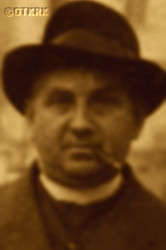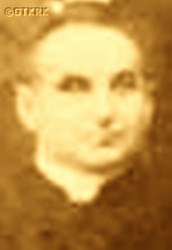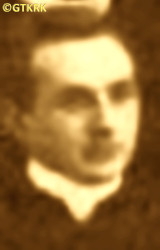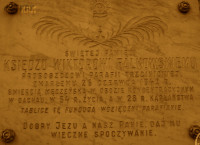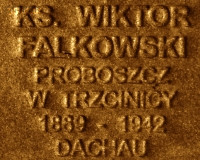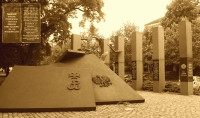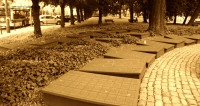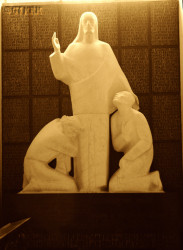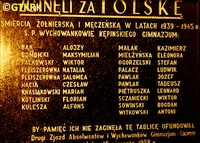Roman Catholic
St Sigismund parish
05-507 Słomczyn
85 Wiślana Str.
Konstancin deanery
Warsaw archdiocese, Poland
full list:
displayClick to display full list

searchClick to search full list by categories
wyświetlKliknij by wyświetlić pełną listę po polsku

szukajKliknij by przeszukać listę wg kategorii po polsku

Martyrology of the clergy — Poland
XX century (1914 – 1989)
personal data
surname
FALKOWSKI
forename(s)
Victor Francis (pl. Wiktor Franciszek)
function
diocesan priest
creed
Latin (Roman Catholic) Church RCmore on
en.wikipedia.org
[access: 2014.09.21]
diocese / province
Gniezno and Poznań archdiocese (aeque principaliter)more on
www.archpoznan.pl
[access: 2012.11.23]
date and place
of death
04.05.1942

TA HartheimSchloss Hartheim „euthanasia” center
today: Alkoven, Eferding dist., Salzburg state, Austria
more on
en.wikipedia.org
[access: 2022.07.18]
alt. dates and places
of death
26.06.1942 (KL Dachau „death certificate” date)
details of death
During studies at Germ. Königliche Katholishe Gymnasium (Eng. Royal Catholic Gymnasium) in Ostrów Wielkopolski member of the clandestine, self‐educational Thomas Zan Society.
In 1918, at the end of World War I, he became a vicar in Ostrów — the seat of the Germ. Kreis Ostrowo (Eng. Ostrów County) in the western part of the Germ. Provinz Posen (Eng. Poznań Province), only 15 km from the border with the so‐called Germ. Königreich Polen (Eng. Kingdom of Poland), i.e. the territory occupied by the Central Powers (i.e. Germany and Austria–Hungary), previously occupied by the occupying Russian authorities until 1915. Was there when the German Emperor William II Hohenzollern abdicated on 09.11.1918; when, after the armistice and ceasefire between the Allies and Germany, signed on 11.11.1918 in a staff wagon in Compiègne, in the headquarters of French Marshal Ferdinand Foch, World War I de facto ended; when, after the Regency Council established by the Germans, operating in the Germ. Königreich Polen, transferred supreme military authority to Brigadier Joseph Piłsudski on 11.11.1918, and appointed him Commander‐in‐Chief of the Polish army, the Polish state was de facto reborn, encompassing however only the Germ. Königreich Polen, but not the lands of the Prussian partition, which were still under German control. This meant that Ostrów found itself right on the border with the reborn Poland.
Conflict with the Germans, who tried to defend their possessions by organizing, i.a. units of the Germ. Grenzschutz Ost (Eng. Eastern Border Guard), a paramilitary volunteer formation that militarily opposed the separation of the eastern territories from Germany, was growing. Polish activists from Ostrów decided to take advantage of the proximity of the border and establish an Ostrów armed unit just across the border, in independent Poland — against the opinion of the Polish Supreme People's Council from Poznań, which feared that such action would be recognized by the victorious Allies as intervention in the affairs of Greater Poland by a third party. It took the name of the 1st Border Battalion. On 27.12.1918, after crossing the border with the passworf „Give me help, fellow countrymen”, 288 Greater Poland men reported to it. At that time, they were stationed in former German barracks in Szczypiorno, c. 15 km from Ostrów.
Became one of three delegates from Ostrów who delivered food and other supplies to the new Polish soldiers in Szczypiorno.
When the Greater Poland Uprising broke out in Poznań on 27.12.1918, the insurgents from Szczypiorno occupied the neighbouring ‐ but on the Germ. Provinz Posen side — Nowe Skalmierzyce on 29‐30.12.1918. A day later, on 31.12.1918, the Poles took over power in Ostrów, also capturing the weapons supplies from military barracks, without firing a single shot. Ostrów became the command centre and the base for the Uprising in this part of Greater Poland, the seat of the military district command and the command of the southern front. The Uprising ended with the armistice in Trier on 16.12.1919, enforced by the victorious Entente states, which recognised the Polish insurgent Greater Poland Army as an allied army and set a border that „German troops were forbidden to cross”, leaving Greater Poland outside their influence. However, it was only the Treaty of Versailles, concluded on 28.06.1919 (after ratifications it came into force on 10.01.1920), that formally awarded Greater Poland to Poland.
After German and Russian invasion of Poland in 09.1939 and start of the World War II, after start of German occupation, arrested by the Germans on 06.10.1941, as part of the action to eliminate the Polish Catholic clergy in the Germ. Reichsgau Wartheland province, established in the occupied Greater Poland region.
Interned in DL Konstantinow transit camp.
From there on 30.10.1941 transported to KL Dachau concentration camp.
Finally totally exhausted taken in a so‐called Germ. „Invalidentransport” (Eng. „Invalids' transport”) to TA Hartheim Euthanasia Center, where murdered in a gas chamber.
According to the death certificate, prepared in KL Dachau, the „honest” otherwise German „medical doctors” and formalists — and at the same time, unrivaled fairy tale spinners — noted that the cause of death was Germ. „Versagen des Kreislaufes bei Herzmuskelentartung” (Eng. „Failure of the circulatory system with heart muscle degeneration”).
prisoner camp's numbers
28123Click to display source page (KL DachauClick to display the description)
cause of death
extermination: gassing in a gas chamber
perpetrators
Germans
sites and events
TA HartheimClick to display the description, «Aktion T4»Click to display the description, KL DachauClick to display the description, DL KonstantinowClick to display the description, 06.10.1941 arrests (Warthegau)Click to display the description, Reichsgau WarthelandClick to display the description, Ribbentrop‐MolotovClick to display the description, Pius XI's encyclicalsClick to display the description, Greater Poland UprisingClick to display the description, Thomas Zan SocietiesClick to display the description
date and place
of birth
21.02.1889Birth certification on:
photos.szukajwarchiwach.gov.pl
[access: 2025.09.17]

Świbatoday: Kępno gm., Kępno pov., Greater Poland voiv., Poland
more on
en.wikipedia.org
[access: 2021.12.18]
parents
FALKOWSKI Charles
🞲 ?, ? — 🕆 ?, ?

KROWIARZ Mary
🞲 ?, ? — 🕆 ?, ?
presbyter (holy orders)
ordination
19.12.1914

Gnieznotoday: Gniezno urban gm., Gniezno pov., Greater Poland voiv., Poland
more on
en.wikipedia.org
[access: 2021.12.18]
Assumption of the Blessed Virgin Mary RC archcathedral churchmore on
en.wikipedia.org
[access: 2025.03.14]
positions held
1933 – 1941
parish priest — Trzcinicatoday: Trzcinica gm., Kępno pov., Greater Poland voiv., Poland
more on
en.wikipedia.org
[access: 2022.07.16] ⋄ St Stanislav the Bishop and Martyr RC parish ⋄ Kępnotoday: Kępno gm., Kępno pov., Greater Poland voiv., Poland
more on
en.wikipedia.org
[access: 2021.05.30] RC deanery — also: c. 1938‐1939 deanery notary; c. 1938‐1939 county inspector of religion classes in elementary schools
1929 – 1933
parish priest — Pruścetoday: Rogoźno gm., Oborniki pov., Greater Poland voiv., Poland
more on
en.wikipedia.org
[access: 2021.07.15] ⋄ St Stanislav the Bishop and Martyr RC parish ⋄ Rogoźnotoday: Rogoźno gm., Oborniki pov., Greater Poland voiv., Poland
more on
en.wikipedia.org
[access: 2021.07.18] RC deanery
c. 1929
administrator — Sobótkatoday: Ostrów Wielkopolski gm., Ostrów Wielkopolski pov., Greater Poland voiv., Poland
more on
en.wikipedia.org
[access: 2021.07.15] ⋄ Nativity of the Blessed Virgin Mary RC parish ⋄ Ołoboktoday: Sieroszewice gm., Ostrów Wielkopolski pov., Greater Poland voiv., Poland
more on
en.wikipedia.org
[access: 2021.07.18] RC deanery — acting („ad interim”)
1920 – 1929
prefect — Rawicztoday: Rawicz gm., Rawicz pov., Greater Poland voiv., Poland
more on
en.wikipedia.org
[access: 2021.07.15] ⋄ Teachers' Seminary ⋄ Annunciation to the Blessed Virgin Mary RC parish ⋄ Rawicztoday: Rawicz gm., Rawicz pov., Greater Poland voiv., Poland
more on
en.wikipedia.org
[access: 2021.07.15] RC deanery — with a break of c. 6 months in 1928, for ministry in the Germ. Regierungsbezirk (Eng. Regency) Kassel in Germany and in Czechoslovakia
1928
curatus/rector/expositus — Drobnintoday: Krzemieniewo gm., Leszno pov., Greater Poland voiv., Poland
more on
en.wikipedia.org
[access: 2022.08.05] ⋄ RC chapel (public, by the school) ⋄ Świerczynatoday: Osieczna gm., Leszno pov., Greater Poland voiv., Poland
more on
en.wikipedia.org
[access: 2020.11.27], St Luke the Evangelist RC parish ⋄ Lesznotoday: Leszno city pov., Greater Poland voiv., Poland
more on
en.wikipedia.org
[access: 2021.07.18] RC deanery — acting („ad interim”)
1918 – 1920
vicar — Ostrów Wielkopolskitoday: Ostrów Wielkopolski urban gm., Ostrów Wielkopolski pov., Greater Poland voiv., Poland
more on
en.wikipedia.org
[access: 2021.06.07] ⋄ St Stanislav the Bishop and Martyr RC parish ⋄ Ostrów Wielkopolskitoday: Ostrów Wielkopolski urban gm., Ostrów Wielkopolski pov., Greater Poland voiv., Poland
more on
en.wikipedia.org
[access: 2021.06.07] RC deanery
1917 – 1918
vicar — Poznańtoday: Poznań city pov., Greater Poland voiv., Poland
more on
en.wikipedia.org
[access: 2021.07.18] ⋄ St Martin the Bishop and Confessor RC parish ⋄ Poznańtoday: Poznań city pov., Greater Poland voiv., Poland
more on
en.wikipedia.org
[access: 2021.07.18] RC deanery
1916
administrator — Biezdrowotoday: Wronki gm., Szamotuły pov., Greater Poland voiv., Poland
more on
en.wikipedia.org
[access: 2021.06.20] ⋄ Exaltation of the Holy Cross and St Nicholas the Biship and Confessor RC parish ⋄ Lwówektoday: Lwówek gm., Nowy Tomyśl pov., Greater Poland voiv., Poland
more on
en.wikipedia.org
[access: 2020.11.27] RC deanery — acting („ad interim”)
1916
vicar — Biezdrowotoday: Wronki gm., Szamotuły pov., Greater Poland voiv., Poland
more on
en.wikipedia.org
[access: 2021.06.20] ⋄ Exaltation of the Holy Cross and St Nicholas the Biship and Confessor RC parish ⋄ Lwówektoday: Lwówek gm., Nowy Tomyśl pov., Greater Poland voiv., Poland
more on
en.wikipedia.org
[access: 2020.11.27] RC deanery
1915 – 1916
vicar — Obornikitoday: Oborniki gm., Oborniki pov., Greater Poland voiv., Poland
more on
en.wikipedia.org
[access: 2020.11.27] ⋄ Blessed Virgin Mary of the Assumption RC parish ⋄ Obornikitoday: Oborniki gm., Oborniki pov., Greater Poland voiv., Poland
more on
en.wikipedia.org
[access: 2020.11.27] RC deanery
till 1914
student — Gnieznotoday: Gniezno urban gm., Gniezno pov., Greater Poland voiv., Poland
more on
en.wikipedia.org
[access: 2021.12.18] ⋄ philosophy and theology, Archbishop's Practical Theological Seminary (Lat. Seminarium Clericorum Practicum)
from 1911
student — Poznańtoday: Poznań city pov., Greater Poland voiv., Poland
more on
en.wikipedia.org
[access: 2021.07.18] ⋄ philosophy and theology, Archbishop's Theological Seminary (Collegium Leoninum)
from c. 1916
membership — Poznańtoday: Poznań city pov., Greater Poland voiv., Poland
more on
en.wikipedia.org
[access: 2021.07.18] ⋄ Friends of Sciences Society
others related
in death
ANDRZEJEWSKIClick to display biography Adam Leo, ARTKEClick to display biography Bronislav Valerian, BALCERZAKClick to display biography Felix, BĄCZEKClick to display biography John, BĄKClick to display biography John, BERENTClick to display biography Leopold Edmund, BIAŁASClick to display biography Paul Joseph, BIOLYClick to display biography Peter, BOMBICKIClick to display biography Gustav John, BORCZUCHClick to display biography John (Bro. Anthony), BRUSKIClick to display biography John, BRYJAClick to display biography Francis, BRYLClick to display biography John, BRZEZIKClick to display biography Ignatius, BRZUSZCZYŃSKIClick to display biography Henry Lucian, BUTKIEWICZClick to display biography Bronislav, CESARZClick to display biography John, CHABOWSKIClick to display biography Vincent Charles, CHOROSZYŃSKIClick to display biography Boleslav, CHWIŁOWICZClick to display biography Aurelius, CHWIŁOWICZClick to display biography Marian, CZAJKOWSKIClick to display biography Marian, CZAPSKIClick to display biography Richard Thaddeus, CZARNECKIClick to display biography Vincent, CZEMPIELClick to display biography Joseph Matthew, DAHLKEClick to display biography Francis Xavier, DOMAGALSKIClick to display biography Leo, DOMAŃSKIClick to display biography Gregory, DOWNARClick to display biography Steven, DRELOWIECClick to display biography Francis, DUSZCZYKClick to display biography Vladislav, DWORNICKIClick to display biography Valentine, DYBIZBAŃSKIClick to display biography John Lamberto, DZIADZIAClick to display biography Felix, DZIEGIECKIClick to display biography John Vladislav, DZIKOWSKIClick to display biography John Michael, ELJASZClick to display biography Vincent, FENGLERClick to display biography Stanislav, FIEWEGERClick to display biography Theophilus, FIJAŁKOWSKIClick to display biography Adam, FISCHBACHClick to display biography John Henry, FORMANOWICZClick to display biography Leo Marian, GAŁCZYŃSKIClick to display biography Steven Joseph, GARWOLIŃSKIClick to display biography Vaclav, GĄSOWSKIClick to display biography John
sites and events
descriptions
TA Hartheim: From 05.1940, in the Germ. Tötungsanstalt (Eng. Killing/Euthanasia Center) TA Hartheim, at the Schloss Hartheim castle in Alkoven in Upper Austria, belonging to KL Mauthausen‐Gusen complex of concentration camps, as part of «Aktion T4» program, the Germans murdered victims — people mentally retarded and disabled — in gas chambers with carbon monoxide. Till 24.08.1941 and the formal end of the «Aktion T4» program, c. 18,000 people were murdered in TA Hartheim. In 04.1941 the program was extended to include concentration camp prisoners. Most, if not all, of the murdered clergy from the KL Dachau concentration camp were taken to TA Hartheim in the so‐called Germ. „Invalidentransport” (Eng. „transport of invalids”), prisoners who were sick and, according to the Germans, „unable to work” (initially under the pretext of transfer to a better camp) — after the formal end of «Aktion T4» as part of the program codenamed «Aktion 14 f 13». It is estimated that at this stage — until 11.12.1944 — c. 12,000 prisoners were gassed at TA Hartheim.
Note: The dates of death of victims murdered in Schloss Hartheim indicated in the „White Book” are the dates of deportations from the last concentration camp the victims where held in. The real dates of death are unknown — apart from c. 49 priests whose names were included in the niem. „Invalidentransports”, but who did not arrive at TA Hartheim. Prob. perished on the day of transport, somewhere between KL Dachau and Munich, and their bodies were thrown out of the transport and cremated in Munich. The investigation conducted by Polish Institute of National Remembrance IPN concluded, that the other victims were murdered immediately upon arrival in Schloss Hartheim, bodies cremated and the ashes spread over local fields and into Danube river. In order to hide details of the genocide Germans falsified both dates of death (for instance those entered into KL Dachau concentration camp books, which are presented in „White Book” as alternative dates of death) and their causes. (more on: ipn.gov.plClick to attempt to display webpage
[access: 2019.05.30], en.wikipedia.orgClick to attempt to display webpage
[access: 2019.05.30])
«Aktion T4»: German state euthanasia program, systematic murder of people mentally retarded, chronically, mentally and neurologically ill — „elimination of live not worth living” (Germ. „Vernichtung von lebensunwertem Leben”). At a peak, in 1940‐1941, c. 70,000 people were murdered, including patients of psychiatric hospitals in German occupied Poland — German formalists noted then that, among others, „performing disinfection [i.e. gassing] of 70,273 people with a life expectancy of up to 10 years saved food in the amount of 141,775,573.80 Deutschmark”. From 04.1941 also mentally ill and „disabled” (i.e. unable to work) prisoners held in German concentration camps were included in the program — denoted then as «Aktion 14 f 13». C. 20,000 inmates were then murdered, including Polish Catholic priests held in KL Dachau concentration camp, who were murdered in Hartheim gas chambers. The other „regional extension” of «Aktion T4» was «Aktion Brandt» program during which Germans murdered chronically ill patients in order to make space for wounded soldiers. It is estimated that at least 30,000 were murdered in this program. (more on: en.wikipedia.orgClick to attempt to display webpage
[access: 2014.10.31])
KL Dachau: KL Dachau in German Bavaria, set up in 1933, became the main German Germ. Konzentrationslager (Eng. concentration camp) KL for Catholic priests and religious during World War II: On c. 09.11.1940, Reichsführer‐SS Heinrich Himmler, head of the SS, Gestapo and German police, as a result of the Vatican's intervention, decided to transfer all clergymen detained in various concentration camps to KL Dachau camp. The first major transports took place on 08.12.1940. In KL Dachau Germans held approx. 3,000 priests, including 1,800 Poles. The priests were forced to slave labor in the Germ. „Die Plantage” — the largest herb garden in Europe, managed by the genocidal SS, consisting of many greenhouses, laboratory buildings and arable land, where experiments with new natural medicines were conducted — for many hours, without breaks, without protective clothing, no food. They slaved in construction, e.g. of camp's crematorium. In the barracks ruled hunger, freezing cold in the winter and suffocating heat during the summer, especially acute in 1941‐1942. Prisoners suffered from bouts of illnesses, including tuberculosis. Many were victims of murderous „medical experiments” — in 11.1942 c. 20 were given phlegmon injections; in 07.1942 to 05.1944 c. 120 were used by for malaria experiments. More than 750 Polish clerics where murdered by the Germans, some brought to TA Hartheim euthanasia centre set up in Schloss Hartheim in Austria and murdered in gas chambers. At its peak KL Dachau concentration camps’ system had nearly 100 slave labour sub‐camps located throughout southern Germany and Austria. There were c. 32,000 documented deaths at the camp, and thousands perished without a trace. C. 10,000 of the 30,000 inmates were found sick at the time of liberation, on 29.04.1945, by the USA troops… (more on: www.kz-gedenkstaette-dachau.deClick to attempt to display webpage
[access: 2013.08.10], en.wikipedia.orgClick to attempt to display webpage
[access: 2016.05.30])
DL Konstantinow: Germ. Durchgangslager Konstantinow (Eng. Transit Camp) — resettlement concentration camp established on 05.01.1940 in Konstantynów Łódzki (c. 10 km west of the center of Łódź), and operational till 16.08.1943. Polish prisoners from Greater Poland (Wielkopolska), Pomerania and central Poland were held there. Approx. 42,000 were interned, thousands of them perished out of which approx. 700 were identified. In 10.1941‐12.1941 approx. 450 Polish priests and religious from Częstochowa, Łódź and Włocławek dioceses and Poznań archdiocese were imprisoned there prior to transport to KL Dachau concentration camp. (more on: pl.wikipedia.orgClick to attempt to display webpage
[access: 2013.08.10], ipn.gov.plClick to attempt to display webpage
[access: 2021.12.19])
06.10.1941 arrests (Warthegau): On 13.09.1941 Germ. Gauleiter (Eng. regional leader) of German province Germ. Reichsgau Wartheland (Eng. Wartheland Reich district), in German‐occupied Greater Poland (where German standard law was in force), Artur Greiser, implementing „Ohne Gott, ohne Religion, ohne Priesters und Sakramenten” — „without God, without religion, without priest and sacrament” — policy issued a decree formally dissolving Catholic Church and forming in its place a Roman Catholic German National Church in Germ. Warthegau, an organization subject to a German private law. The ordinance was issued backdated to 01.09.1939, i.e. the date of the German invasion of Poland, which sanctioned the later robbery of the property of the Catholic Church acting for the benefit of the Polish population by the Germans. All the contacts with Vatican were forbidden. All the religion congregations were also dissolved. Soon after, on 06‐07.10.1941, mass arrests of Polish Catholic priests took place — c. 352 were detained. All were herded into DL Konstantinow in Konstantynów or IL Lond in Ląd on Warta river transit camps or KL Posen concentration camp (in this case, the detainees were first registered, photographed and examined in the infamous Poznań headquarters of the German political police, the Gestapo, in the former Soldier's House). On 30.10.1941 most of them were transported to KL Dachau concentration camp.
Reichsgau Wartheland: After the Polish defeat in the 09.1939 campaign, which was the result of the Ribbentrop‐Molotov Pact and constituted the first stage of World War II, and the beginning of German occupation in part of Poland (in the other, eastern part of Poland, the Russian occupation began), the Germans divided the occupied Polish territory into five main regions (and a few smaller). The largest one was transformed into Germ. Generalgouvernement (Eng. General Governorate), intended exclusively for Poles and Jews and constituting part of the so‐called Germ. Großdeutschland (Eng. Greater Germany). Two were added to existing German provinces. From two other separate new provinces were created. Greater Poland region was one of them, incorporated into Germany on 08.10.1939, by decree of the German leader Adolf Hitler (formally came into force on 26.10.1939), and on 24.01.1940 transformed into the Germ. Reichsgau Wartheland province, in which the law of the German state was to apply. The main axis of the policy of the new province, the territory of which the Germans recognized as the Germ. „Ursprünglich Deutsche” (Eng. „natively German”), despite the fact that 90% of its inhabitants were Poles, was Germ. „Entpolonisierung” (Eng. „Depolonisation”), i.e. forced Germanization. C. 100,000 Poles were murdered as part of the Germ. „Intelligenzaktion”, i.e. extermination of Polish intelligentsia and ruling classes. C. 630,000 were forcibly resettled to the Germ. Generalgouvernement, and their place taken by the Germans brought from other areas occupied by Germany (e.g. the Baltic countries, Bessarabia, Bukovina, etc.). Poles were forced to sign the German nationality list, the Germ. Deutsche Volksliste DVL. As part of the policy of „Ohne Gott, ohne Religion, ohne Priesters und Sakramenten” (Eng. „No God, no religion, no priest or sacrament”) most Catholic priests were arrested and sent to concentration camps. All schools teaching in Polish, Polish libraries, theaters and museums were closed. Polish landed estates confiscated. To further reduce the number of the Polish population, Poles were sent to forced labor deep inside Germany, and the legal age of marriage for Poles was increased (25 for women, 28 for men). The German state office, Germ. Rasse‐ und Siedlungshauptamt (Eng. Main Office of Race and Settlement) RuSHA, under the majesty of German law, abducted several thousand children who met specific racial criteria from Polish families and subjected them to forced Germanization, handing them over to German families. After the end of hostilities of World War II, the overseer of this province, the Germ. Reichsstatthalter (Eng. Reich Governor) and the Germ. Gauleiter (Eng. district head) of the German National Socialist Party, Arthur Karl Greiser, was executed. (more on: en.wikipedia.orgClick to attempt to display webpage
[access: 2024.06.21])
Ribbentrop‐Molotov: Genocidal Russian‐German alliance pact between Russian leader Joseph Stalin and German leader Adolf Hitler signed on 23.08.1939 in Moscow by respective foreign ministers, Mr. Vyacheslav Molotov for Russia and Joachim von Ribbentrop for Germany. The pact sanctioned and was the direct cause of joint Russian and German invasion of Poland and the outbreak of the World War II in 09.1939. In a political sense, the pact was an attempt to restore the status quo ante before 1914, with one exception, namely the „commercial” exchange of the so‐called „Kingdom of Poland”, which in 1914 was part of the Russian Empire, fore Eastern Galicia (today's western Ukraine), in 1914 belonging to the Austro‐Hungarian Empire. Galicia, including Lviv, was to be taken over by the Russians, the „Kingdom of Poland” — under the name of the General Governorate — Germany. The resultant „war was one of the greatest calamities and dramas of humanity in history, for two atheistic and anti‐Christian ideologies — national and international socialism — rejected God and His fifth Decalogue commandment: Thou shall not kill!” (Abp Stanislav Gądecki, 01.09.2019). The decisions taken — backed up by the betrayal of the formal allies of Poland, France and Germany, which on 12.09.1939, at a joint conference in Abbeville, decided not to provide aid to attacked Poland and not to take military action against Germany (a clear breach of treaty obligations with Poland) — were on 28.09.1939 slightly altered and made more precise when a treaty on „German‐Russian boundaries and friendship” was agreed by the same murderous signatories. One of its findings was establishment of spheres of influence in Central and Eastern Europe and in consequence IV partition of Poland. In one of its secret annexes agreed, that: „the Signatories will not tolerate on its respective territories any Polish propaganda that affects the territory of the other Side. On their respective territories they will suppress all such propaganda and inform each other of the measures taken to accomplish it”. The agreements resulted in a series of meeting between two genocidal organization representing both sides — German Gestapo and Russian NKVD when coordination of efforts to exterminate Polish intelligentsia and Polish leading classes (in Germany called «Intelligenzaktion», in Russia took the form of Katyń massacres) where discussed. Resulted in deaths of hundreds of thousands of Polish intelligentsia, including thousands of priests presented here, and tens of millions of ordinary people,. The results of this Russian‐German pact lasted till 1989 and are still in evidence even today. (more on: en.wikipedia.orgClick to attempt to display webpage
[access: 2015.09.30])
Pius XI's encyclicals: Facing the creation of two totalitarian systems in Europe, which seemed to compete with each other, though there were more similarities than contradictions between them, Pope Pius XI issued in 03.1937 (within 5 days) two encyclicals. In the „Mit brennender Sorge” (Eng. „With Burning Concern”) published on 14.03.1938, condemned the national socialism prevailing in Germany. The Pope wrote: „Whoever, following the old Germanic‐pre‐Christian beliefs, puts various impersonal fate in the place of a personal God, denies the wisdom of God and Providence […], whoever exalts earthly values: race or nation, or state, or state system, representatives of state power or other fundamental values of human society, […] and makes them the highest standard of all values, including religious ones, and idolizes them, this one […] is far from true faith in God and from a worldview corresponding to such faith”. On 19.03.1937, published „Divini Redemptoris” (Eng. „Divine Redeemer”), in which criticized Russian communism, dialectical materialism and the class struggle theory. The Pope wrote: „Communism deprives man of freedom, and therefore the spiritual basis of all life norms. It deprives the human person of all his dignity and any moral support with which he could resist the onslaught of blind passions […] This is the new gospel that Bolshevik and godless communism preaches as a message of salvation and redemption of humanity”… Pius XI demanded that the established human law be subjected to the natural law of God , recommended the implementation of the ideal of a Christian state and society, and called on Catholics to resist. Two years later, National Socialist Germany and Communist Russia came together and started World War II. (more on: www.vatican.vaClick to attempt to display webpage
[access: 2023.05.28], www.vatican.vaClick to attempt to display webpage
[access: 2023.05.28])
Greater Poland Uprising: Military insurrection of Poles of former German Germ. Posen Provinz (Eng. Poznań province) launched against German Reich in 1918‐1919 — after the abdication on 09.11.1918 of the German Emperor William II Hohenzollern; after the armistice between the Allies and Germany signed on 11.1.1918 in the HQ wagon in Compiègne, the headquarters of Marshal of France Ferdinand Foch — which de facto meant the end of World War I — against the German Weimar Republic, established on the ruins of the German Empire, aiming to incorporate lands captured by Prussia during partitions of Poland in XVIII century into Poland. The Republic of Poland, reborn on 11.11.1918, initially formally included only the so‐called Germ. Königreich Polen (Eng. Kingdom of Poland), i.e. the territory that had been under Russian rule until 1915 and then under the control of Central States (Germany and Austria–Hungary), but did not include the Prussian partition. Started on 27.12.1918 in Poznań and ended on 16.02.1919 with the armistice pact in Trier, forced by the victorious Entente states, which included provisions ordering Germany to cease operations against Poland and, importantly, recognizing the Polish insurgent Greater Poland Army as an allied armed force of the Entente. De facto it turned out to be a Polish victory, confirmed in the main peace treaty after World War I, the Treaty of Versailles of 28.06.1919, which came into force on 10.01.1920 and in which most of the lands of the Prussian partition were recognized as Polish. Many Polish priests took part in the Uprising, both as chaplains of the insurgents units and members and leaders of the Polish agencies and councils set up in the areas covered by the Uprising. In 1939 after German invasion of Poland and start of the World War II those priests were particularly persecuted by the Germans and majority of them were murdered. (more on: en.wikipedia.orgClick to attempt to display webpage
[access: 2016.08.14])
Thomas Zan Societies: Secret societies of Polish youth, aiming at self‐education, patriotic in form and content, functioning 1830‐1920, in mutiny against enforced Germanisation and censure of Polish culture, mainly in secondary schools — gymnasia — mainly in Greater Poland (Wielkopolska) and later in Silesia. The first groups were formed in 1817. In 1897 a congress in Bydgoszcz was held when rules of clandestine activities were formulated. At other congress in Bydgoszcz in Poznań a „Red Rose” society was formed, heading all others groups in various gymnasiums and coordinating their activities. In 1900 „Red Rose” consolidated Philomaths organizations from Pomerania as well. After Toruń trial of Pomeranian Philomaths in Toruń Germans arrested 24 members of Thomas Zan Society from Gniezno. 21 of them were sentenced up to 6 weeks in prison and reprimands. All were relegated from schools without the right to continue education in secondary and higher schools in Prussia. Despite repression the Societies existed till 1918 and rebirth of Poland. (more on: pl.wikipedia.orgClick to attempt to display webpage
[access: 2021.12.19])
sources
personal:
www.wtg-gniazdo.orgClick to attempt to display webpage
[access: 2012.11.23], tpl-lukus.kepno.plClick to attempt to display webpage
[access: 2013.06.23], www.kepnosocjum.plClick to attempt to display webpage
[access: 2016.03.14], photos.szukajwarchiwach.gov.plClick to attempt to display webpage
[access: 2025.09.17], www.ipgs.usClick to attempt to display webpage
[access: 2012.11.23]
bibliographical:
„International Tracing Service (ITS), Bad Arolsen, GermanyClick to display source page”, Arolsen Archives
original images:
www.kepnosocjum.plClick to attempt to display webpage
[access: 2013.06.23], tpl-lukus.kepno.plClick to attempt to display webpage
[access: 2013.06.23], tpl-lukus.kepno.plClick to attempt to display webpage
[access: 2020.09.18], www.kepnosocjum.plClick to attempt to display webpage
[access: 2013.12.04], www.kepnosocjum.plClick to attempt to display webpage
[access: 2021.07.15]
LETTER to CUSTODIAN/ADMINISTRATOR
If you have an Email client on your communicator/computer — such as Mozilla Thunderbird, Windows Mail or Microsoft Outlook, described at WikipediaPatrz:
en.wikipedia.org, among others — try the link below, please:
LETTER to CUSTODIAN/ADMINISTRATORClick and try to call your own Email client
If however you do not run such a client or the above link is not active please send an email to the Custodian/Administrator using your account — in your customary email/correspondence engine — at the following address:

giving the following as the subject:
MARTYROLOGY: FALKOWSKI Victor Francis
To return to the biography press below:
 Click to return to biography
Click to return to biography








